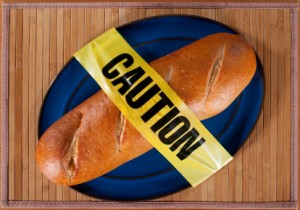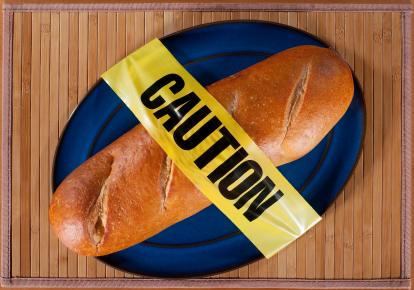For general prepping, information abounds as to what foods to set aside for emergency situations and meal preparation when living off the grid. For the person with gluten or wheat issues, however, the selection of foods is often drastically narrowed. This is especially true with many commercially produced mixes and kits. Until the day that one or more of the prepping companies decides to cater to the gluten-free crowd, those who wish to avoid gluten must do their research and read every label.
What Is Gluten And Why Avoid It?
 Gluten is the component of grains such as wheat, barley, and rye that enables dough made from that grain to have an elastic texture. It helps the bread to rise, keep its shape during baking, and improves bread quality.
Gluten is the component of grains such as wheat, barley, and rye that enables dough made from that grain to have an elastic texture. It helps the bread to rise, keep its shape during baking, and improves bread quality.
So, what’s the big deal, and why are there so many people embracing the gluten-free lifestyle? One might think that gluten-free eating is simply the lastest fad and moneymaking scheme of the food industry. Since the 1950s, cases of celiac disease have quadrupled, making the disease present in at least 1 percent of the populations in the U.S., European nations, and other countries around the world. Celiac is a condition where, when the person consumes gluten, the body responds by attacking and damaging the mucosa in the small intestine. Once the mucosa are damaged, the body can no longer absorb the minerals and other nutrients it needs, and the person’s health goes down from there. Food allergies often present themselves, as well as skin conditions and a whole host of other health problems, as the intestine is damaged. If caught in time, going on a gluten-free diet is the most effective treatment for those with a celiac diagnosis.
According to Dr. Ludvigsson, one doctor who has studied celiac and related diseases, there is also a health condition called latent celiac (also known as gluten sensitivity), where the person has “normal small intestinal mucosa but positive celiac disease serology,” which means that the person should still avoid gluten, even if it doesn’t seem to bother them. Gluten (and wheat in general) has been shown to play a role in causing many health problems beyond celiac and gluten sensitivity, and the cause is often missed. Even the most modern-day testing is not 100 percent accurate, and many people who go gluten-free find that they feel much better and decide to make it a lifestyle.
One other thing to consider is that wheat, the main gluten-containing grain that is consumed in the U.S., is one of the top eight allergens in the U.S., and gluten-free information can be an aid in avoiding the allergen.
Where Is Gluten Hiding?
Gluten is hidden in many foods, especially processed foods, and one must learn the names of ingredients in which it can hide and read every label to make sure the food is safe. Even when you think you have found a trusted product, ALWAYS read the labels every time you go to the store, as companies change their product ingredients from time to time and without warning.
Some examples of ingredients to look out for and to use caution with when avoiding gluten are:
- Flours: whether white or whole wheat, barley, spelt or rye, they are still in the wheat family and therefore contain gluten
- Oats: while gluten-free in their natural form, most commercial oats are cross contaminated on production lines with gluten containing food sources (such as wheat)
- Beer
- Malt: often made from barley, and in such foods as crisp rice cereals
- Soy Sauces: read labels!
- Teriyaki Sauces
- Dry Roasted Nuts
- Coloring
- Dextrin
- Fat Replacer
- Flavoring
- Food Starches
- Ground Spices: often have flour added
- Stabilizers
This is a mere sampling of where gluten can hide. A more detailed listing can be found at the link in the sources at the end of this article.
Are Gluten-Free Products Considered Health Food?
It is important to note that many foods that are labeled “Gluten Free ” are really junk food in disguise, being filled with simple starches/carbs and sugar. Gluten-free does not equal health food, and a gluten-free diet does not guarantee you will lose weight.
So, although foods labeled gluten-free are a good option for those that need to avoid gluten, they are not necessarily nutrient-dense, healthy foods to consume on a regular basis. Whatever your health needs, it is important to look for foods that pack a nutritional punch and aren’t loaded with empty calories.
Now that I have covered the reasons one might choose to eat gluten-free, here are some tips for basic gluten-free eating and emergency prepping.
The Basics
Prepping for emergency situations can get expensive really fast. Add in specialized foods and the expense can be prohibitive and cause us throw up our arms in frustration, ready to give up before we’ve even started. Don’t despair! There are ways to create a gluten-free stash that won’t cost a fortune.
One easy way to prep gluten-free is to simply purchase a little more of your regular fare and set it aside. Flours and grains that might go bad or get buggy over time can be put in the freezer. In fact, a few weeks of freezer time can kill larvae and eggs in your flours and grains (yep, they’re in there), making them good for long-term prepping. Simply remove them from the freezer and allow them to come to room temperature on the counter to avoid any moisture in your long-term storage, then place them in an airtight bucket with an air purifying bag to absorb any remaining moisture and seal completely.
Dehydrating foods that you know to be gluten-free can be a great way of saving money as well. I use and recommend an Excalibur food dehydrator. With a dehydrator, you can dry just about any type of food and make your own lightweight snacks, food mixes, and kits without the worry of whether a factory really made your food gluten-free. Pick up a how-to manual with specific information pertaining to what you want to dehydrate and get started!
Although not necessary, a vacuum sealer can be handy in making your dry foods last longer. This can even be used to package things such as flours and homemade trail mixes, keeping pests out and keeping the foods inside fresh.
Canning is another way to preserve your own foods for long-term storage that is cost-effective and also happens to be a suitable way to feed your family off the grid, especially if you are staying in one place. If need be, canned foods can be eaten right out of the jar with little to no prep, making them ideal if cooking is not an option. Information and supplies for canning are becoming more available as people are tightening their budgets in today’s economy. Pick up a how-to manual and canning supplies and get started with some summer produce! Some foods do not require a pressure canner, while others do. If you are not quite ready to invest in a pressure canner and want to can something that requires one, such as meats, see if you can borrow one from a friend. You may even get a free lesson out of the deal!
Protein
In day-to-day living, as well as in a survival situation, protein is a must. Too often, wheat gluten is present in the meat substitutes in shelf-stable, long-term food storage kits. Textured vegetable protein (TVP) holds a lot of nutrition and is attractive for preppers due to its low cost and the fact that it is lightweight, an attractive feature for the bug-out bag. While TVP can be made from soy, it can also be made from a whole host of other food sources (including wheat), and additives and flavoring boost the likelihood of gluten being present. If you opt for using TVP, make sure there is no gluten present in the product, even in trace amounts.
Here is a list of good gluten-free protein options. As always, read your labels!
- Simple canned meats: look for small cans that can be divided into bug-out bags and larger cans for long-term, family use
- Dried meats: watch out for Hydrolyzed Protein of any type
- Combine beans, lentils, peanuts and other legumes with rice, corn, millet, or quinoa
- Nuts and seeds (and nut butters)
Vegetables and Fruits
Options for vegetables and fruits abound for the gluten-free prepper. Generally, most are gluten-free. However, two things to watch out for are sauces and breading, which often contain flour. Always read labels.
Grains And Seeds
While one way to avoid gluten is to avoid all grains, you might find that adding some gluten-free grains into your repertoire might help to extend the staying power of your meals. Not all grains contain gluten, and not all foods that we might consider grains are true grains—many are seeds!
Following are some ideas for gluten-free grains and seeds:
- Gluten-free oats: regular oats are contaminated with wheat on production lines—use your own judgement based on what you know about your health
- Brown rice and white rice
- Quinoa
- Millet
- Buckwheat
- Chia
- Flax: whole, unground, as ground flax will quickly go rancid
- Amaranth
- Job’s Tears, a.k.a. Coix Seeds or Chinese Pearl Barley, available in Chinese markets
Beverages
I have found beverages to be one of the easier categories to navigate in my gluten-free quest. There are two things of note that I tell my gluten-free friends to be aware of. One is that many alcoholic beverages contain gluten in some form (especially beer). Watch out for malt in your beverages and dry mixes! As always, (yes, I’m going to say it again), read labels.
The second thing to be aware of is the connection between gluten sensitivity and coffee. While most coffees, especially plain black unflavored coffees, do not contain gluten, people who do not do well with gluten might need to avoid all coffee. Even decaffeinated coffee. Why? Because a recent study shows that 10 percent of coffee is a protein that crosses with gluten antibodies. So, the body reads it as gluten and responds accordingly. If you have celiac disease, I would recommend finding a different drink of choice. If you have other issues with wheat/gluten aside from celiac, you may or may not have problems with it. Use your own judgement based on your body’s response, and supply your food stash accordingly.
Fluff Foods
Many would say that in prepping, one must include some junk food to keep everyone happy and stave off appetite fatigue. I have thus far not recommended the starch-laden gluten-free options that seem to abound in grocery stores today. Simple starches, like sugar, give a quick jolt of energy, but that jolt is followed by a slump as the blood sugar quickly plummets. This is the reason I have not recommended the starchy gluten-free foods for regular consumption—we need sustaining foods in an emergency situation, and the focus must be on those.
But we do need some treats, and this is where I would recommend picking up some gluten-free mixes that can be quickly and easily prepared or that are already in open-and-eat form.
Examples of storable “fluff foods” are snack bars such as Larabars or KIND bars; cereals such as Honey Nut Chex or Envirokidz Peanut Butter Panda Puffs; trail mixes made with marshmallows, chocolate chips and dried fruit and nuts; and corn tortilla chips and canned salsa or hummus (homemade is easy to make), and easy-prep gluten-free mixes.
For Convenience: Commercial Foods
Commercially prepared foods all too often contain gluten in some form. It is wise to apply your day-to-day gluten-free knowledge as you develop your family’s food storage investments. Since commercial prepping foods tend to be on the more expensive end of the food prep spectrum, it is wise to call the company to double check that their posted labels are up to date. You cannot always rely on the person on the other side of the phone to know as much as you do about gluten, but it doesn’t hurt to ask whether there is gluten in specific products you are interested in. They may have to contact their distributor, and it may take a few days, but be patient. Often, when they take the time to investigate, you are more likely to get an accurate, up-to-date answer.
One company that provides a fairly good selection of grab-and-go, easy-prep foods is www.solutionsfromscience.com. While every selection is not gluten-free, there are enough offerings to make it worth your while to consider purchasing long-term, shelf-stable items from them. As always, read labels every time, and I would recommend contacting the company to ensure that their nutritional and ingredient listings on the website are up to date.
Remember, do not rely solely on allergy disclaimers to determine gluten content; the top eight allergens are often in all caps at the end of the ingredient listing to guide you to gluten-free foods, but even if “WHEAT” is not listed, there can still be other gluten-containing ingredients in the food, such as that from barley and rye. I found a few foods in the listing that did not have “WHEAT” in the allergy listing, yet they still contained wheat/gluten. Something to be aware of.
Happy prepping!
Please take responsibility for your own health care. This article was written based on information about the products at time of publication. Companies often change their formulas and recipes, so read labels and double-check that these recommendations are the right choice for you!
Sources:
Destiny Stone, “Celiac Disease Diagnoses On the Rise”, 8/11/2010, http://www.celiac.com/articles/22252/1/Celiac–Disease–Diagnoses–On–the–Rise/Page1.html, (accessed June 19, 2012).
Scott Adams, “Unsafe Gluten-Free Food List (Unsafe Ingredients)”, 11/27/2007, http://www.celiac.com/articles/182/1/Unsafe–Gluten–Free–Food–List–Unsafe–Ingredients/Page1.html, (accessed June 19, 2012).
Dr. David Clark, DC, “Coffee and Gluten Sensitivity – Surprising News”, 9/9/2011, http://drclark.typepad.com/dr_david_clark/2011/09/coffee–and–gluten–sensitivity–surprising–news.html, (accessed June 20, 2012).
https://www.solutionsfromscience.com
©2012 Off the Grid News










